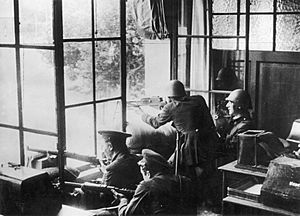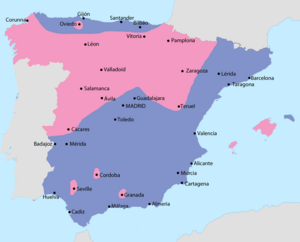Spanish coup of July 1936 facts for kids
Quick facts for kids Spanish coup of July 1936 |
|||||||
|---|---|---|---|---|---|---|---|
| Part of the Spanish Civil War | |||||||
 Republican soldiers and Assault Guards fighting in Barcelona during the uprising. |
|||||||
|
|||||||
| Belligerents | |||||||
| Commanders and leaders | |||||||
The Spanish coup of July 1936 was a military uprising in Spain. It was an attempt by a group of army officers and conservative politicians, known as the Nationalists, to take over the government of the Second Spanish Republic. The coup began on July 17, 1936, in Spanish Morocco and spread to mainland Spain on July 18.
The rebels hoped for a quick victory and to take control of the country right away. However, the government and its supporters, called the Republicans, fought back. This led to a split in Spain, with different parts of the country controlled by different sides. Instead of a fast takeover, the coup started the long and bloody Spanish Civil War. This war eventually led to a strict government led by Francisco Franco, who became the dictator of Spain.
The government kept control of many important cities like Málaga, Jaén, and Almería. But the rebels took Cádiz and Seville. In Madrid, the capital, rebels were trapped in a building called the Montaña barracks, which was later taken by government forces after a lot of fighting. On July 19, the new prime minister, José Giral, told people to arm themselves to fight the rebels. This helped defeat the rebels in Madrid, Barcelona, and Valencia.
After this, groups like anarchists took control of large areas in Aragon and Catalonia. General Goded, a rebel leader, gave up in Barcelona and was later sentenced to death. About half of the Spanish Army joined the rebels. This included the 30,000-strong Army of Africa, which was Spain's most skilled fighting force. The government had fewer weapons and experienced officers, but they had more ships and planes.
Contents
Why the Coup Happened
Spain had been going through a tough time with a lot of political disagreements. After elections in November 1933, the country entered a period that some called the "black biennium." During this time, different political groups, including those who wanted a king (monarchists) and those who supported a strong, one-party government (fascists), were preparing for change. They even got support from leaders like Benito Mussolini in Italy.
José-María Gil-Robles led a right-wing party called CEDA. His party's youth group copied similar groups in Germany and Italy. Another group, the Falange Española, which was fascist, became more popular. There was a lot of violence in the streets between different political groups.
In 1934, a big strike by workers was put down very harshly. General Francisco Franco helped lead the military effort against a miners' strike in Asturias. Many workers and government soldiers died. This event showed how divided and violent Spain had become. After this, political parties started forming their own armed groups.
In the 1936 general election, a group of left-wing parties called the Popular Front won by a very small margin. The Nationalists, who were against the Popular Front, decided they would try to overthrow the government instead of working with it. The government was weak, and there was a lot of violence. Many generals believed the government needed to be replaced to prevent Spain from falling apart.
Planning the Uprising
The Republican government tried to move generals they didn't trust to different places. For example, Francisco Franco was sent to the Canary Islands, and General Goded was sent to the Balearic islands. Emilio Mola was moved to Pamplona, which actually allowed him to plan the uprising on the mainland. General José Sanjurjo became the main leader of the plan, and Mola was the chief planner.
Franco was a very important part of the plan because he was well-respected in the Spanish Moroccan Army, which was Spain's strongest military force. He wrote a letter to the prime minister, Casares Quiroga, hinting that the military was disloyal. But Casares Quiroga did not act on this warning. On July 5, a plane was arranged to take Franco from the Canary Islands to Morocco, arriving on July 14.
The Murder of José Calvo Sotelo
A key event that sped up the coup was the murder of José Calvo Sotelo. On July 12, 1936, a member of a fascist group killed a police officer named José Castillo. The next day, police officers from the Assault Guards arrested José Calvo Sotelo, a leading conservative politician who was against the government's reforms. They shot him without a trial.
The killing of Calvo Sotelo, a well-known member of parliament, and the fact that police were involved, made the government's opponents very angry. This event gave the Nationalist generals a reason to start their planned uprising. They said Spain needed to be saved from chaos by military force. Some politicians, like Indalecio Prieto, wanted to give weapons to the people to fight the military, but the prime minister was unsure.
The Uprising Begins
The uprising was planned to start on July 18 at 5 AM in Morocco. Most military bases in Spain were supposed to join a day later. The rebels hoped it would be a quick takeover, but the government managed to keep control of most of the country.
In Spanish Morocco, the rebels quickly took control. The 30,000 soldiers of the Army of Africa were very professional. Many of its officers supported the rebels. When the plan was discovered on July 17, the uprising started immediately in Morocco. Rebel soldiers moved into working-class areas and shot trade union members. Generals loyal to the Republic were executed. There was little resistance, and 189 people were shot by the rebels. Generals Goded and Franco quickly took control of the islands they were assigned to.
On July 18, Prime Minister Casares Quiroga refused help from workers' unions and said that only Spanish Morocco had joined the rebels. He insisted that people should trust legal ways to deal with the uprising and that giving out weapons would be against the law. However, the main workers' unions called for a general strike, which was like a call to arms. They opened hidden weapon stashes.
Coup in Military Districts
Spain was divided into eight military districts. Most of the top military leaders in these districts were not part of the plan to overthrow the government. The rebels mostly relied on mid-level officers to take control of military bases. In some areas, like Zaragoza and Seville, the rebel plan was well organized. In other places, like Valencia, the plan was weaker.
- Madrid: The general in charge of Madrid knew about the plan but didn't join. Other generals tried to lead the rebellion, but they were defeated. The main rebel stronghold, the Montaña barracks, was taken by government forces.
- Seville: The commanders in Seville were loyal to the government. But a rebel officer, José Cuesta Monereo, had built a strong rebel network. On July 18, General Gonzalo Queipo de Llano took over the military base. The loyalist commander was arrested.
- Valencia: The commanders in Valencia were not part of the plot. The rebels there were less organized. For about two weeks, the military in Valencia didn't take a clear side. Eventually, some rebel leaders fled.
- Barcelona: The commander in Barcelona was loyal to the Republic. General Goded arrived to lead the rebellion, but the military was quickly overwhelmed by armed citizens. Goded was arrested and later executed.
- Zaragoza: Both the commander, Miguel Cabanellas Ferrer, and his chief of staff were active in the plot. Because of this, almost all the troops in the district followed the rebel orders. Cabanellas remained in command after the successful coup.
- Burgos: The commander, Domingo Batet Mestres, tried to stop the uprising. But the rebel network was very strong. On July 19, rebels took over key positions. Batet refused to join and was arrested and executed.
- Valladolid: The commander was not involved in the plot. However, a group of senior rebel officers from Madrid took over the military structures. The commander was arrested, and the rebels took control.
- La Coruña: The commander was not aware of the plot. The rebel network here was disorganized. The commander tried to arrest some of his staff, but the rebels quickly fought back and arrested him instead. He was later executed.
What Happened Next
The rebels failed to take most major cities, except for Seville. Seville was very important because it allowed Francisco Franco's African troops to land there. Areas that were mostly conservative and Catholic, like Old Castile and León, quickly fell to the rebels. In Pamplona, the uprising was celebrated.
In Madrid, the Montaña barracks fell after heavy fighting. The government then gave weapons to ordinary people. This helped defeat the army uprising in major industrial centers like Madrid, Barcelona, and Valencia. But it also meant that anarchist groups in Barcelona and parts of Aragon and Catalonia armed themselves and took control of many services.
Meanwhile, the Army of Africa crossed the Gibraltar Strait. They used planes given by Nazi Germany. This was the world's first long-distance movement of troops by air. Franco's troops joined General Gonzalo Queipo de Llano's forces in Seville. Their quick movements allowed them to secure most of northern and northwestern Spain, as well as parts of southern Spain.
The Republican government ended up controlling most of the eastern Spanish coast and the central area around Madrid. They also held parts of northern Spain like Asturias, Cantabria, and the Basque Country. General Mola, a rebel leader, wanted to create fear in areas controlled by the Nationalists. There was a big crackdown on people who supported the left. In areas controlled by the government, there were also acts of revenge against people seen as fascists or conservatives.
About 11 million of Spain's 25 million people lived in areas controlled by the Nationalists. The rebels had about half of Spain's army, around 60,000 men. In Republican army units, many officers either rebelled or disappeared, which made these units weaker. The Army of Africa, which was Spain's strongest fighting force, was fully under Nationalist control. The rebels also gained support from police forces.
The government kept about 200,000 rifles out of 500,000. They also had about a third of the heavy and light machine guns and 387 out of 1,007 artillery pieces. The Republicans had 10 out of 18 modern tanks. In terms of ships, the Nationalists took control of 17 warships, leaving the Republicans with 27. However, the Nationalists had the two most modern cruisers. The Republican navy also lost many officers. The government kept two-thirds of the air force, but the planes were old.
The coup failed to quickly overthrow the government, but it successfully started the Spanish Civil War.
See also
 In Spanish: Golpe de Estado en España de julio de 1936 para niños
In Spanish: Golpe de Estado en España de julio de 1936 para niños
- List of Spanish Nationalist military equipment of the Spanish Civil War
- List of Spanish Republican military equipment of the Spanish Civil War
|


